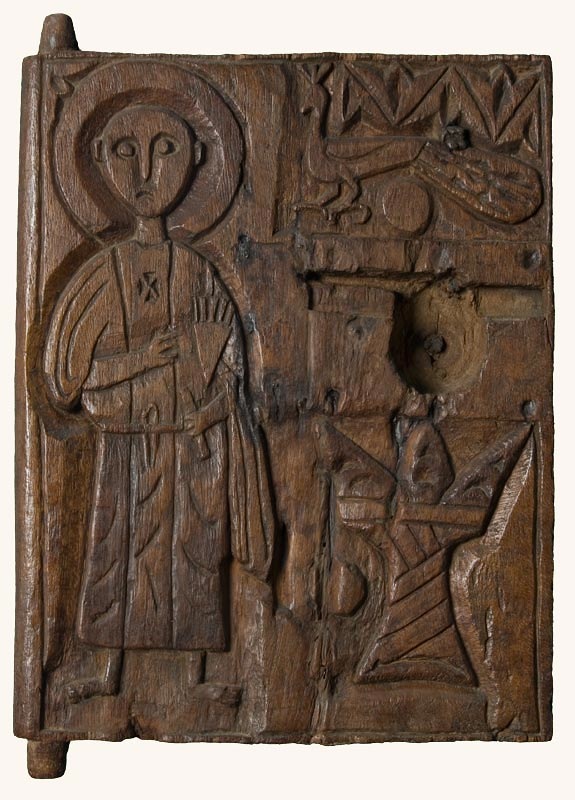
Our previous posts in this series have defined and problematised magical texts, and the difference between applied texts and formularies, before looking at their spread over time and space. This week we’re going to look at them as physical objects, focusing on the materials or “supports” on which they are written. These can tell us a great deal about the production and function of their texts, and their place in the history of writing.
Although our project is called “Coptic Magical Papyri”, a more accurate, if less catchy title, would be “Coptic Magical Manuscripts”. Alongside papyrus, Coptic-language magical texts were written on a wide range of other materials, including parchment and leather, paper, different types of wooden and metal tablets, and ostraca – fragments of limestone and ceramic. Here, though, we are following a slightly idiosyncratic use of “papyrus” in the field of papyrology, where some scholars use it as a general term to refer to any movable writing support. As we’ve noted before though, even this is slightly too narrow, since we also have a few (6) wall inscriptions in our corpus.

The use of these different materials was determined by factors such as the availability and expense of different materials, and their symbolic meaning (or inherent “magical” power, depending on your perspective). As you can see in the above graph, some materials were much more widely used than others, and they all show patterns of change over the period we are studying – the third to twelfth centuries CE. We can see these patterns even more starkly if we look at the percentage usage of the major writing supports, rather than their absolute numbers:

In the third century, papyrus is clearly the dominant material, although parchment becomes an important secondary material from the fourth century onwards, and pottery and limestone ostraca remain as less-used tertiary supports throughout the period. The biggest change is in the tenth century, when paper suddenly replaces papyrus as the main writing support. It’s interesting to note that each of these shifts has been noted by previous authors who have looked at other genres of texts from Egypt – the extensive use of parchment from the fourth century, the replacement of papyrus by paper in the tenth, can also be seen in literary, and to a lesser extent, documentary texts. So let’s briefly take each of the materials in turn, and explore their production and use, beginning with the papyri.
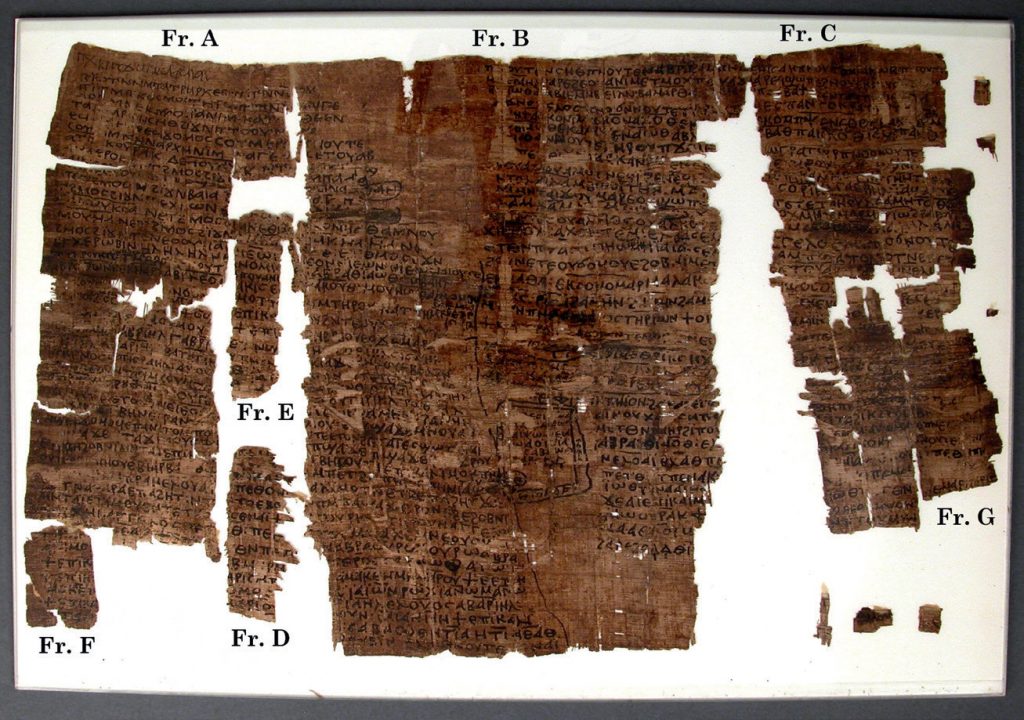
Of the 492 manuscripts whose materials are noted in our database, 199, or 40.5%, are written on papyrus. This is not really surprising, as papyrus was used for writing in Egypt from the beginning of the third millennium BCE. By the time Egyptians started to write in Coptic it had already been the predominant material for over three thousand years. Papyrus is famously made from a plant of the same name (Cyperus papyrus) which was grown along the Nile. Interestingly, it doesn’t seem to have been native to Egypt – it grows best in shallow swamps, and the regular Nile flood disrupted its growth, so that it must have been introduced to Egypt, and required human cultivation to survive. For this reason, papyrus seems to have gone extinct in Egypt shortly after the 10th century, when paper overtook papyrus as a cheap and flexible writing material. The plant survived in other parts of the Mediterranean; Arabs introduced it to Sicily, where a museum of papyrus now exists in the city of Syracuse. From here, some plants were taken to the Jardin de Luxembourg in Paris, and it was these same plants that were used to reintroduce papyrus to Egypt in the late nineteenth century.
The exact method of producing papyrus is not known; modern examples are notably different from the ancient sheets, but this shouldn’t be surprising – lost skills developed over the course of thousands of years are not easily recoverable. The Roman author Pliny the Elder provides us with the most detailed surviving description of the production of papyrus, but although he would have used it for writing his books, he probably never saw it being produced in Egypt, and his account has some inconsistencies. Nonetheless, we know that the stem of the papyrus plant was cut, and that the outer layer was removed before the inner pith was peeled or sliced into thin strips, which were arranged to form sheets, and pounded so that the sap bound these individual sheets together. These were then glued together to produce long rolls – reaching at times 30 metres or even more – which were often far whiter and far smoother than surviving sheets might suggest. Age has roughened their surface, and changed their colour to become more brown, red or yellow, although different qualities existed even in the past. As we’ve noted, papyrus was the predominant writing surface used for all writing in the ancient Mediterranean, magical texts included. For this reason, we find every kind of magical text on papyrus, from long handbooks in codex or roll form, to folded amulets and scraps containing curses or working notes.
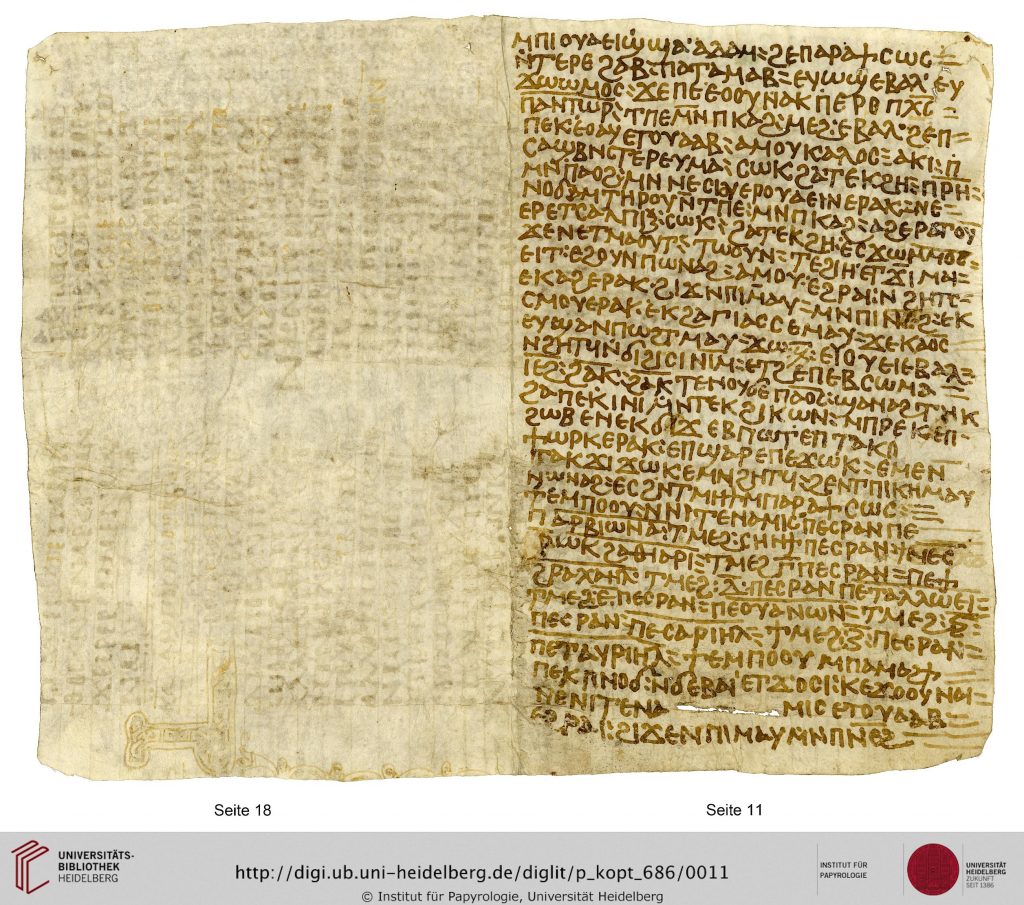
The next most common support is parchment, of which our database has 133 examples written upon in Coptic. Parchment takes its name from the city of Pergamon in modern Turkey; according to a probably legendary account, the Egyptian king Ptolemy V Epiphanes (205-180 BCE) banned the import of papyrus to Pergamon in an attempt to prevent the city from having a larger library than his own in Alexandria, prompting them to begin writing on treated animal skins. In fact we have earlier evidence of writing on animal skins from the Near East, and even in Pharaonic Egypt leather was sometimes used to produce documents which would be tougher than those written on papyrus.
Parchment is created through the death of an animal – usually a goat, calf, or sheep – whose skin is pulled from its body and stretched before being scraped of hair as it dries, and treated with alum and chalk. Depending on the size of a sheet of parchment, the skin of each animal might produce between four and sixteen pages, so that larger books, like the 800-page Codex Sinaiticus, would have required hundreds of deaths. For this reason, parchment was more expensive than papyrus – Roger Bagnall estimates that it could be 2.5 times the price – and therefore preferred for more important literary texts. Perhaps for this reason, most of the Coptic magical texts written on parchment are on small, odd-shaped scraps – perhaps the leftovers created when producing sheets – or palimpsests, written after washing off the previous text which was written on the parchment. Nonetheless, like papyrus, parchment doesn’t seem to have been considered to have any special properties – it was used to write all kinds of texts, even if it would have been slightly more expensive, and more durable, than papyrus.
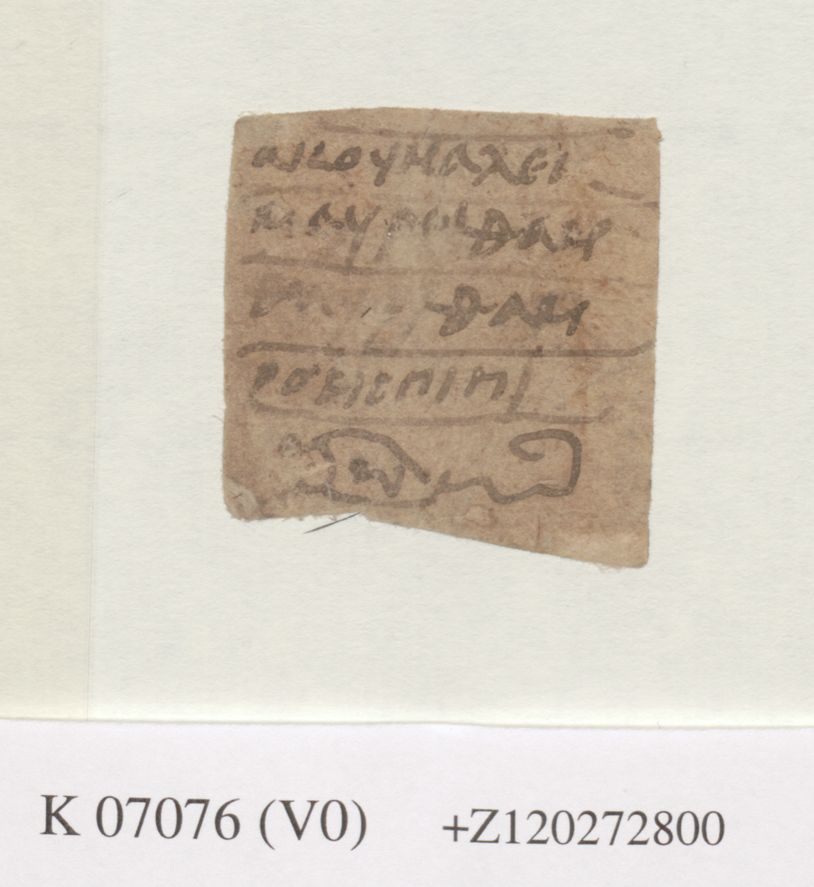
The next most common support is paper, the material upon which 78 of our manuscripts are written. While modern paper is produced from wood pulp, the first paper, developed in China in the second century BCE, was produced by recycling rags made from vegetable fibres – principally hemp and rattan. These would be soaked, pounded, and then left to dry on screens, with the cellulose fibres binding to produce an even but durable surface. The technology for producing paper spread to the Islamic world in the eighth-century CE. Another legendary story says that the Arab commander Ziyad ibn Salih captured Chinese papermakers after conquering the city of Talas, in modern Kazakhstan, in 751 CE. Papermaking had spread to Syria by the ninth century, and the earliest well-dated manuscripts from Egypt date to the tenth. Flax, for producing linen, was a major crop in medieval Egypt, and so linen cloth, as well as that made from cotton and hemp, was plentiful. Scraps of cloth would be collected by ragmen, who would then sell it to be made into paper. As a recycled waste product, paper was therefore relatively cheap, and so quickly replaced the more labour-intensive papyrus. Jonathan Bloom notes that the cheapness of this material may have spurred literary developments in the Islamic world, just as it would later spur the development of printing in Europe; examples of such developments include the translation of Greek scientific texts into Arabic, and the writing of fantastic tales such as those of the One Thousand and One Nights, whose earliest copy, dating to the late ninth century, was found in Egypt and written upon paper.
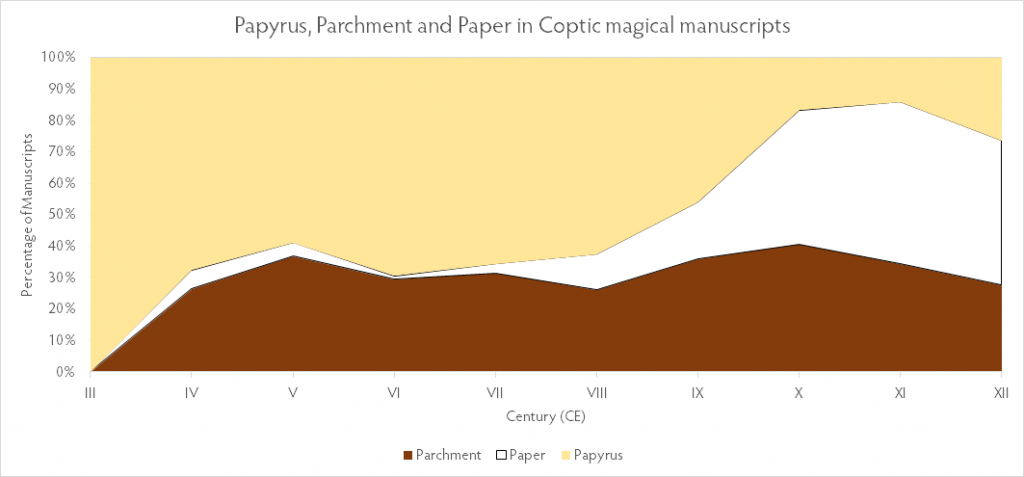
We can see the replacement of papyrus by its namesake, paper, very clearly in the above graph, which shows only these two major supports, and their more upscale triplet, parchment. The use of parchment remains fairly stable, at around 30% of the total magical texts in these three material, between the fourth and twelfth centuries. The remainder is made up by papyrus, which is quickly replaced by paper in the tenth century. Note that, according to the numbers in our database, we have a few magical texts from Egypt written on paper as early as the fourth century, but this is certainly wrong. At this stage of our project, we often rely on previous editions, and so mistakes in dating can occasionally produce odd outliers of the kind seen here. As we correct the dates by examining the manuscripts directly, we will probably see all the examples of paper before the tenth century disappear, and a more consistent pattern develop.
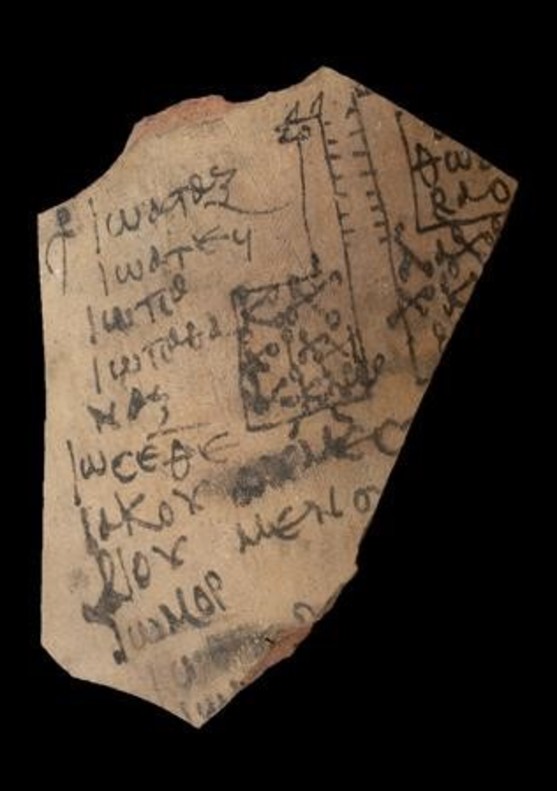
While papyrus, parchment and paper are “unmarked” – that is, they could be used to write any kind of magical text, this may not be true for other materials, as Sebastian Richter has noted. The term “ostracon” (originally meaning “shell” in Greek) is used for two different materials from Egypt – fragments of pottery, and the flakes of limestone which can be found in abundance throughout the desert. Despite their difference, both types had the same names – blje in Coptic, ostrakon in Greek, and they served a similar function – a writing support which could be gathered without cost in the near desert. Among other types of texts, ostraca are frequently used for writing short letters, although there are some legal texts written on ostraca, and they could also be used to copy literary texts by those learning to write. Among magical texts, they occupy an interesting position. Although they were occasionally used to copy short recipes, the majority of examples are applied texts, and usually curses or love spells. It seems that ostraca were useful as cheap objects which could be written upon in rituals, and then easily buried wherever necessary – in a grave, crossroads, or at someone’s door, depending on the victim and the instructions. Some magical recipes even prescribe the use of pottery ostraca – specifically from the red pottery made in Aswan in southern Egypt – so it may be that it was believed to have a special power. At the same time, we also find a significant number of texts which might be amulets written on ostraca – short prayers, or passages from the Psalms or Gospels. These might be writing exercises, but in at least some cases they were probably amulets, intended to be displayed in a place which might need protection, and we know from the letters of a monk named Frange, who lived near modern Luxor in the early 8th century CE, that he sometimes produced amulets on ostraca which were tied round the necks of animals to protect them. The case of wooden tablets, of which we have 5 examples in our database, is quite similar: they generally contain short religious texts, which might have been hung up as amulets, although we cannot be certain.

The last two significant materials, lead and bone, present an even stronger example of “markedness”. Lead was a cheap and plentiful substance in much of the ancient Mediterranean, easily pounded or melted to produce sheets which could be written upon with any sharp implement and then soft enough to fold by hand. For this reason, it was the main material used for the curse tablets which appear in the Greek-speaking world in the sixth century BCE, a practice which later spread all the way to Britain and the Near East. Interestingly, lead seems to have taken on an additional association – as a cold, hard metal, curses often bind their victims to a kind of living death, lying as cold and motionless as the lead upon which the curses are written. The three Coptic texts we have written on lead tablets all seem to be curses, using similar language to that found in the earlier Greek examples. Something apparently unique to Egypt, however, is the use of bone for such curses – we have four examples, all from the south of Egypt, written on the ribs of large mammals, although the editors of the four texts disagree on whether they are camel, cow, or even human; three of them are written in red ink, which James Drescher suggested might even be blood, although it has never been scientifically analysed. While bone was occasionally used as a writing support for more mundane purposes in Egypt – we have a few accounting and other types of documentary texts on bone – it seems that in magic it was only used for curses. Like lead, bone may have been believed to have sympathetic powers, taken from a dead animal, it might project a deathlike state on its victims.
While studying the materials on which texts are written might not seem important at first, it can have very interesting results. As we have seen, the use of papyrus, parchment and paper broadly follows their use in literary and even documentary texts, showing that the producers of magical manuscripts followed the norms of their larger social context. At the same time, applied magical texts often seem to have diverged by relying on particular material qualities of their support – the usefulness of wood and ostraca as objects which could easily be hung or buried according to their ritual use, and the sympathetic qualities of lead and bone – cold and heavy, or plucked from a once-living, now-dead, creature.
References and Further Reading
Bagnall, Roger. Early Christian Books in Egypt. Princeton: Princeton University Press, 2009.
A discussion of early Christian manuscripts, focusing on their material aspects. Pages 50-69 have a useful discussion of the expenses of producing manuscripts using different materials.
Bloom, Jonathan. Paper Before Print: The History and Impact of Paper in the Islamic World. Yale: Yale University Press, 2001.
A very useful book with a discussion of the history and materiality of paper, which also contains discussions of early materials.
Boud’hors, Anne. “Manuscrits coptes de papier (xie-xive siècle) : quelques éléments de caractérisation”. In Le papier au Moyen-Age: histoire et techniques, edited by Monique Zerdoun Bat-Yehouda. Paris: Turnhout, 1999, 87-84. [URL]
A discussion of the use of paper in dated Coptic manuscripts.
Bülow-Jacobsen, Adam. “Writing Materials in the Ancient World”. In The Oxford Handbook of Papyrology, edited by Roger Bagnall. Oxford: Oxford University Press, 2009, 3-29. [URL]
A very useful introduction to the different writing materials used in the ancient world.
Buzi, Paola & Stephen Emmel. “Coptic Codicology”. In Comparative Oriental Manuscript Studies: An Introduction, edited by Alessandro Bausi et al. Hamburg: COMSt, 2015, 137-153. [URL]
de Bruyn, Theodore. Making Amulets Christian: Artefacts, Scribes, and Contexts. Oxford: Oxford University Press, 2017. URL
A general overview of the material characteristics of early Christian amulets, which contains a useful discussion of materials on pages 44-48.
Drescher, James. “A Coptic Malediction.” Annales du Service des antiquités de l‘Égypte (ASAE) 48 (1948), p. 267-276.
Publication of two bones containing curses, which suggests they might have been written in blood.
Grob, Eva Mira. “Documentary Arabic Private and Business Letters on Papyrus: Form and Function, Content and Context”. Berlin – New York: De Gruyter, 2010. [URL]
Discussion of the use of papyrus for Arabic letters, with a useful discussion of the decline of papyrus in the tenth century.
Kahl, Jochem. “Magical Bone”. In Asyut, Tomb III: Objects, edited by Jochem Kahl et al. Wiesbaden: Harrassowitz Verlag, 2016, 332-337.
Publication of Asyut Tomb III S05/46, the curse written on a bone whose image is shown here.
Martín Hernández, Raquel, and Torallas Tovar, Sofìa. “The Use of the Ostracon in Magical Practice in Late Antique Egypt.” Studi e Materiali di Storia delle Religioni 80 (2014): 780–800. [URL]
Discussion of the use of Ostraca in Demotic, Greek, and Coptic magic.
Richter, Tonio Sebastian. “Markedness and Unmarkedness in Coptic Magical Writing.” In Écrire la magie dans l’Antiquité – Scrivere la magia nell’Antichità: Proceedings of the International Workshop (Liège, October 13–15, 2011), Papyrologica Leodiensia 5, edited by Magali de Haro Sanchez. Liège: Presses universitaires de Liège, 2015, 85–108, plates VII-XIII.
An article summarising the usage of different materials in Coptic magical manuscripts, using smaller a corpus of 189 manuscripts, but with very similar results.
